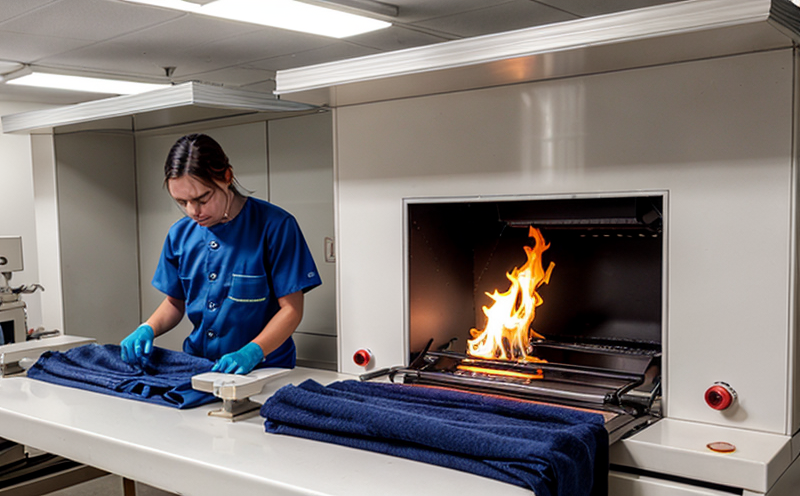Flammability Testing of Upholstery Fabrics for Clothing Applications
The flammability testing of upholstery fabrics used in clothing applications is a critical aspect of ensuring public safety, particularly in environments where textiles are exposed to potential ignition sources. This service involves rigorous evaluation of fabric resistance to combustion and the rate at which it can spread. Upholstery fabrics used in clothing must comply with various international standards such as ISO 17492 for the measurement of heat release rate, smoke production index, and oxygen index.
The process begins with careful selection of test specimens that are representative of the fabric to be tested. The specimen is then prepared according to the relevant standard, ensuring it accurately reflects real-world usage conditions. Once prepared, the fabric undergoes testing in a controlled environment using specialized equipment such as Cone Calorimeter and Oxygen Index apparatus.
The primary goal of this service is to prevent the ignition or spread of fire by identifying potential hazards early on. By conducting thorough flammability tests, manufacturers can ensure that their products meet stringent safety requirements set forth by regulatory bodies worldwide.
Flammability testing helps identify any weaknesses in the design or manufacturing process which could lead to increased risk during use. For instance, if a particular type of fabric fails these tests, further investigation into its composition and structure may be necessary to improve fire resistance properties.
In summary, flammability testing plays an essential role in safeguarding lives by reducing risks associated with clothing fires. It provides valuable insights into how different materials behave under extreme conditions, enabling informed decisions about material selection and design modifications where needed.
Scope and Methodology
The scope of this service includes testing upholstery fabrics used in clothing applications to determine their flammability properties. The methodology follows internationally recognized standards like ISO 17492, which specifies procedures for measuring heat release rate (HRR), smoke production index (SPI), and oxygen index.
- Heat Release Rate: Measures the amount of heat released per unit area over time when exposed to an ignition source.
- Oxygen Index: Determines the minimum concentration of oxygen required for a fabric to sustain combustion.
- Smoke Production Index: Quantifies the quantity of smoke generated during flaming and non-flaming combustion phases.
The testing process typically involves placing the prepared specimen in a controlled environment where it is exposed to an ignition source. Various sensors within the apparatus measure key parameters such as temperature, heat flux, mass loss rate, and smoke opacity.
| Parameter | Description |
|---|---|
| Heat Release Rate (HRR) | Amount of heat released per unit area over time during combustion. |
| Oxygen Index | Minimum oxygen concentration needed for a fabric to sustain flaming combustion. |
| Smoke Production Index (SPI) | Quantification of smoke produced during the testing process. |
The results obtained from these tests are analyzed comprehensively and reported back to clients along with recommendations for improvement if necessary. Compliance with specific standards is crucial, especially when working towards certification or regulatory approval.
Eurolab Advantages
At Eurolab, we pride ourselves on delivering high-quality services that meet the highest industry standards. Our state-of-the-art facilities and experienced team ensure accurate and reliable results every time. Here are some key advantages of choosing our flammability testing service:
- Comprehensive Testing: We offer a full range of tests covering all aspects of fabric flammability.
- Accurate Results: Utilizing cutting-edge technology and adhering strictly to international standards guarantees precise measurements.
- Expertise: Our technicians have extensive experience in this field, ensuring thorough analysis and interpretation of data.
- Custom Solutions: We tailor our services to meet the specific needs of each client, whether it's for research or compliance purposes.
- Rapid Turnaround Times: Efficient processes allow us to deliver results quickly without compromising on quality.
- Compliance Support: Our team can provide guidance throughout your product development process to ensure full compliance with relevant regulations.
- Confidentiality: All client information and test data are kept strictly confidential, ensuring peace of mind for our customers.
Our commitment to excellence sets us apart from other laboratories. With Eurolab, you can trust that your textiles will undergo rigorous yet fair testing, leading to safer products and increased confidence in market readiness.
Use Cases and Application Examples
- Clothing Manufacturers: Ensure compliance with flammability standards for new product launches.
- Retailers: Verify that imported fabrics comply before sale to consumers.
- R&D Engineers: Develop safer and more durable materials through iterative testing and improvement cycles.
- Procurement Departments: Assess suppliers' capabilities by verifying their compliance with industry norms.
In real-world applications, flammability tests play a vital role in preventing accidents. For example, a clothing manufacturer might use our service to check the flammability of newly sourced fabrics before incorporating them into production lines. Retailers could employ this service during quality control checks at ports of entry. R&D teams can benefit from continuous monitoring and optimization of fabric formulations.
A specific instance involves a company that specializes in outdoor gear. They use our testing services to ensure their jackets meet the stringent flammability requirements set by international standards like ISO 17492. Another example includes an e-commerce platform that requires all suppliers to undergo this test as part of its quality assurance program.





